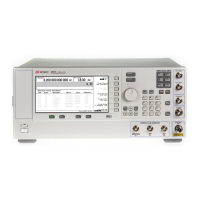E8257D/67D, E8663D PSG Signal Generators Service Guide
Troubleshooting
Troubleshooting Non–Harmonic Spurious
1-81
10. Using delta marker, read the harmonic power level on the spectrum analyzer. Compare the spectrum analyzer
reading to the specifications in Table 1- 27 on page 1- 78.
11. If the harmonics do not meet specification, replace the A27 40 GHz Doubler.
50 and 67 GHz Models Only
Use this procedure to troubleshoot harmonic problems with a fundamental frequency between 20 GHz and 25 GHz for
Option 550, and between 20 GHz and 33.5 GHz for Option 567.
1. Set the signal generator as follows:
• Frequency: set to harmonic frequency to be measured
• Amplitude +10 dBm
•ALC Off
• Amplitude Power Search (softkey)
2. Remove the cable from the A30 Modulation Filter output going to the A36 Quadraplier (W107). Connect the
spectrum analyzer to A30 Modulation Filter (J2).
3. Set the spectrum analyzer to the harmonic frequency and press marker peak search and delta marker.
4. Set the signal generator frequency to the fundamental frequency of the harmonic.
5. Using the delta marker, read and record the harmonic power level on the spectrum analyzer.
6. Reconnect the cable to the A30 Modulation Filter (J2) and remove the cable from the A36 Quadraplier output
(W112). Connect the spectrum analyzer to the A36 Quadraplier (J3).
7. Set the signal generator and spectrum analyzer to the harmonic frequency. Press marker peak search and delta
marker.
8. Set the signal generator to the fundamental frequency of the harmonic.
9. Using delta marker, read the harmonic power level on the spectrum analyzer. There should be a decrease in the
harmonic power level from what was measured in step 3, at the output of the A30 Modulation Filter. If there isn’t,
or if the decrease is less than 15 dB, replace the A36 Quadraplier.
10. If the harmonics are decreased, replace the A30 Modulation Filter.
Troubleshooting Non–Harmonic Spurious
There are nine different groupings a spur can fall into. The grouping determines what assembly is most likely
generating the spur. The procedure for troubleshooting spurs is to identify the grouping based on failing a
performance test, checking for loose or broken cables or castings, and replacing the assembly.
Table 1-28 Non Harmonic Spurs
Mixing Spurs These spurs are generated by the mixing products of the RF and IF signals on the
A8 Output. The instrument is tuned to a frequency in the Heterodyne–Band
(250 kHz to 250 MHz) to measure these spurs.
Power Supply Spurs These spurs are generated by the power supply switching at a 100 kHz rate. If the
test fails for these spurs, change A19 Power Supply.
Offset Reference Spurs These spurs are generated by the 10 MHz frequency reference on the A7 Reference.
Clock Spurs Two clocks on the A11 Pulse/Analog Modulation Generator generate these spurs.
The first clock is 33.554432 MHz and is used by the numeric synthesizer. The
second clock is 100 MHz and is used by the internal pulse generator.
RF and LO Feedthrough
Spurs
When the instrument is tuned to a Heterodyne Band (250 kHz to 250 MHz)
frequency, the RF and LO feeds through from the mixer on the A8 Output
generates spurs on the RF output.
Frac–N Feedthrough These spurs are generated by the Frac–N frequency coupling onto the low–band
signal as it leaves the A6 Frac–N. The spurs then appear at the Frac–N frequency
at the RF output.

